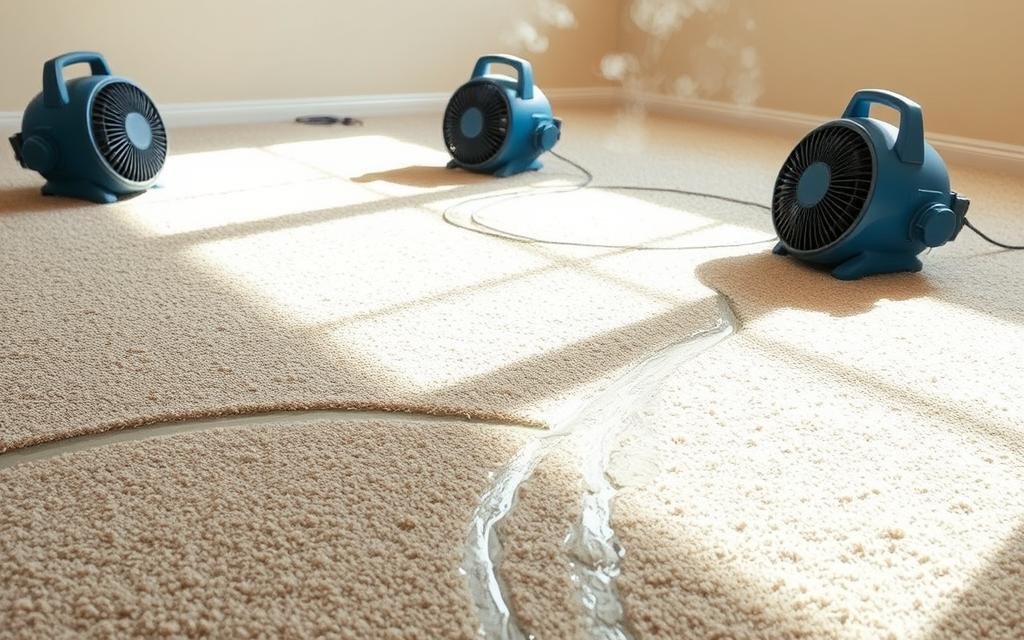Did you know over 14,000 people in the U.S. face water damage emergencies daily? A flooded carpet can be a big problem, affecting your space’s look and health risks from mold and bacteria. This guide will cover key steps for drying flooded carpets and restoring water damage. Quick action is key to avoid long-term damage and ensure a successful recovery.
Let’s explore useful tips and techniques for drying your carpets quickly. These will help restore your carpets and your peace of mind.
Key Takeaways
- Timely action is critical in flooded carpet recovery.
- Removing standing water can prevent further damage.
- Proper air circulation aids in effective drying.
- Utilizing dehumidifiers can significantly speed up the drying process.
- Be cautious of possible health risks from mold growth.
Understanding the Causes of Flooded Carpets
Knowing why carpets get flooded is key to fixing them. Carpets can get damaged from many sources in the home. By understanding these, I can prevent and fix floods faster.
Common Sources of Water Damage
Here are some common reasons for flooded carpets:
- Severe weather, like heavy rain or storms
- Broken pipes or leaky faucets
- Washing machines that overflow
- Clogged drains or toilets that overflow
Spotting these sources early helps me act fast. When I see water, I can fix the problem before it gets worse. For more info, I check out detailed resources on carpet damage from flooding.
Signs Your Carpet is Flooded
Knowing the signs of flooding is important. Look out for:
- Discoloration of the carpet, which means water damage
- A damp smell that shows moisture
- The carpet feeling excessively moist or heavy
If I see these signs, I act quickly. Spotting flooding early helps avoid big damage. Fixing the problem and drying the area fast keeps my carpets safe and my home safe.
Immediate Steps to Take After Water Exposure
After water exposure, acting fast is key. My first step is to ensure my safety during flooding. I watch out for dangers like submerged electrical wires. Before entering a flooded area, I turn off power sources to avoid electrical shocks.
If the water looks contaminated or has sewage, I call professionals. This helps reduce health risks.
Ensuring Personal Safety
Wet conditions can be dangerous. I carefully check the area for hazards. My safety during flooding is a top priority.
I follow safety rules, like wearing rubber boots and gloves. This helps protect me.
Turning Off Power Sources
Before stepping on wet carpets, I make sure the electricity is off. This includes unplugging devices and turning off circuit breakers. These steps help prevent injuries.
Removing Furniture and Valuables
After ensuring safety, I protect valuables from water. I quickly move furniture and items at risk of damage. This action helps prevent loss and aids in recovery.
I also document any significant damage. This might be needed for insurance claims later.
Effective Techniques for Drying Flooded Carpets
When my carpets get flooded, I use a mix of strategies to dry them. The right carpet drying techniques are key to fixing them. I’ll share important methods like wet/dry vacuum cleaning, improving air flow, and using dehumidifiers.
Using Wet/Dry Vacuums
Wet/dry vacuum cleaning is a top choice for removing water from carpets. These vacuums pull out a lot of water fast. I move slowly over the carpet to get as much moisture out as I can.
The Importance of Air Circulation
Good air flow is also critical for drying carpets. I open windows and use fans to improve air movement. Renting industrial air movers helps even more. This speeds up drying and prevents mold.
Employing Dehumidifiers
Dehumidifiers help dry the carpet faster. They pull moisture from the air, helping the carpet dry and preventing mold. Using a dehumidifier with wet/dry vacuum cleaning and air flow makes drying more effective.
Professional Help: When to Call in Experts
Knowing when to ask for help with water damage is key. Sometimes, I realize I need experts when my drying efforts don’t work. Signs like damp carpets and mold growth mean I need professional help.
Signs You’ve Hit a Stalemate
- Evidence of mold or mildew, even in hidden spots.
- Carpets stay damp, no matter how hard I try to dry them.
- Bad smells that won’t go away, even after drying.
Benefits of Hiring Restoration Services
Calling a water damage restoration company can really help. They have the tools and know-how for professional water extraction. They also know how to stop mold from growing after floods.
Having a team of experts handle the problem lets me focus on other recovery tasks. It’s a big relief to know the pros are on it.
Preventive Measures for Future Incidents
To avoid the distress of flooded carpets in the future, I know I must take steps now. Regular upkeep of plumbing and appliances is key. This helps lower the chance of leaks and flooding in my home.
Regular Maintenance Tips
Keeping my home safe from water damage means regular checks on pipes and appliances. I look for signs of wear or corrosion early on. Cleaning gutters and ensuring good drainage also help prevent flooding.
Installing Water Sensors
Installing water sensors is another smart move. These devices warn me of water issues early. Placed in leak-prone spots, they help protect my home from damage.
Understanding Your Home’s Vulnerability
Knowing my home’s weak spots is also critical. I check areas at risk of flooding and the state of my plumbing. With a plan tailored to my home, I can make it safer and reduce water damage risks.
